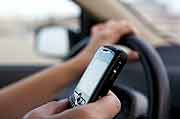
FRIDAY, April 3, 2015 (HealthDay News) — Most U.S. states now have bans on texting while driving, and those laws may be preventing some serious traffic accidents, a new study suggests.
Researchers found that car-crash hospitalizations dipped in states that instituted relatively strict bans on texting and driving between 2003 and 2010.
Overall, the hospitalization rate in those states declined by 7 percent versus states with no bans, the researchers report in the American Journal of Public Health.
The findings cannot prove that texting bans caused the shift, said study leader Alva Ferdinand, an assistant professor at Texas A&M School of Public Health.
But, she added, her team tried to account for the other factors that could explain the decline — like laws on speeding, drunk driving, handheld cellphones and teen driving restrictions.
And texting bans were still linked to a decline in hospitalizations for traffic accidents.
Specifically, the benefit was seen in states with “primarily enforced” texting bans, Ferdinand said.
That means law enforcement can pull drivers over just on suspicion of texting.
“Some states have secondary enforcement,” Ferdinand explained. “In those states, law enforcement has to catch you doing something else first — like speeding or running a red light — and then determine that you were texting.”
For those states, and the few with no texting bans at all, the new findings might nudge them to review their policies, Ferdinand said.
Jake Nelson, director of traffic safety advocacy for the AAA, agreed. “The more data we have showing benefits, the better,” said Nelson, whose organization supports laws against texting while driving.
And since this study focused on hospitalization rates only, Nelson said, “the results are probably a conservative estimate of the full impact of texting bans.”
Right now, 45 states and Washington, D.C., ban all drivers from texting, according to the Governors Highway Safety Association (GHSA), which represents state highway safety agencies.
Of those states, most have primary enforcement of the law, but five do not. The five states that do not ban all drivers from texting do have certain limits — such as prohibiting “novice” drivers from texting, according to the GHSA.
But contrary to popular belief, it’s not only teenagers who text at the wheel, Ferdinand pointed out.
“It’s adults, too,” she said. “They’re constantly checking emails and text messages.”
Jonathan Adkins, executive director of the GHSA, made the same point. “It’s actually adults between the ages of 25 and 40 who are the biggest offenders,” he said.
In fact, Ferdinand’s team found that texting bans were more strongly linked to benefits among adults, not teens. The laws were tied to a 9 percent reduction in car-crash hospitalizations among Americans aged 22 and older; there was also a decline among younger people, but it was not statistically significant.
But that does not mean texting bans make no difference for young drivers and passengers, Ferdinand stressed.
In an earlier study, her team found that the bans were linked to a dip in fatal accidents among all age groups.
Now that hard data is coming in, Adkins said, it should encourage states with no texting bans to consider them. “And it should push those states with weaker laws to strengthen them,” he added.
For individual drivers, Adkins said, the message is straightforward: Don’t text behind the wheel — even if you think you excel at “multitasking.”
For one, he noted, you may be wrong. Plus, he said, “you need to be able to drive defensively, to protect yourself against other drivers who are distracted.”
Nine Americans are killed every day in accidents that involve a driver who was distracted by some other activity — like using a cellphone or eating, according to the U.S. Centers for Disease Control and Prevention.
Texting, the CDC says, is especially dangerous, because people have to take their hands off the wheel, their eyes off the road and their minds off of what they’re doing.
More information
The U.S. Centers for Disease Control and Prevention has more on distracted driving.
Copyright © 2025 HealthDay. All rights reserved.

